Abstract
Alarming environmental changes and the threat of natural fuel resource extinction are concerning issues in human development. This has increased scientists’ efforts to phase out traditional energy resources and move on to environmentally friendly biofuels. In this study, non-edible castor oil was transesterified with methanol using a manganese-doped zinc oxide (Mn-doped ZnO) nanocatalyst. A heterogeneous nanocatalyst was prepared by means of the the sonochemical method. X-ray diffraction (XRD), energy dispersive X-ray spectroscopy (EDX), and transmission electron microscopy (TEM) were used to characterize these nanocatalysts. The transesterification reaction was studied under different temperature conditions, different ratios of methyl alcohol to castor oil, and different amounts of the catalyst to identify optimum conditions in which the maximum yield of biodiesel was produced. The maximum biodiesel yield (90.3%) was observed at 55 °C with an oil-to-methanol ratio of 1:12, and with 1.2 g of nanocatalyst. The first-order kinetic model was found to be the most suitable. Several thermodynamic parameters were also determined, such as activation energy, enthalpy, and entropy. We found that this transesterification was an endergonic and entropy-driven reaction. The results showed that the Mn-doped ZnO nanocatalyst could be a suitable catalyst for the heterogeneous catalytic transesterification process, which is essential for biodiesel production.
1. Introduction
All natural energy sources (coal, natural gas, petroleum, and so on) are nonrenewable. These energy resources are being gradually phased out due to the rapid progress of urbanization and industrialization. The world is concerned about the depletion of natural resources and the reliance of human progress on these energy sources. As a result, it is becoming increasingly important to alternative energy sources [1]. Biofuels are becoming a focus of research due to their environmental friendliness and chemical and physical properties which are similar to those of petroleum. Scientists are also interested in replacing petroleum diesel with biofuels with similar characteristics [2]. Researchers have predicted that the overall demand for natural gas will rise by up to 53% over the next two decades. Developed and developing countries will require 50% more fuel to meet their transportation and domestic needs, respectively. In 2006, the International Energy Outlook (IEO) predicted that demand for petroleum and related products would increase to 115.0 million barrels per day from 83.0 million barrels per day. Natural resources will not be able to meet the demand for fuel, and the opposite trend of increasing demand and decreasing energy resources will cause fuel prices to rise to dangerous levels [3].
Over the last few decades, biodiesel production has received much attention as a renewable energy resource. Researchers have developed methods for producing biodiesel based on animal and plant extracts [4]. Yan et al. claimed that by utilizing modified ZnO, they were able to produce biodiesel from crude algal oil, corn oil, crude palm oil, crude soybean oil, crude coconut oil, waste cooking oil, and food-grade soybean oil [5]. Wang et al. reviewed the use of ZnO-based nanocatalysts for biodiesel production using natural raw materials. Soliman et al. successfully employed ZnO nanoparticles for the production of biodiesel from different carboxylic esters in the presence of various alcohols [6]. They summarized several systems that can be used for stabilizing ZnO-based nanocatalytic systems because bare nanoparticles aggregate, resulting in a loss of catalytic efficiency. ZnO doped with other metals has also been examined, exhibiting enhanced catalytic efficiency. The mechanism of the hydrolytic reaction for biodiesel production was also been explored in that review article [7]. Jayakumar et al. recently reviewed heterogeneous catalytic systems for biodiesel production. Homogeneous catalysis usually presents problems such as high cost, low rates, and difficult removal from mixtures. Therefore, the authors claimed that heterogeneous catalytic systems were better for transesterification reactions. In their review article, they claimed that natural bio-waste materials could be used to synthesize heterogeneous catalytic systems. They summarized several natural materials that produce such heterogeneous catalytic systems [8]. Raw materials for biodiesel production can be easily obtained from animals and plants. Preferably, the raw material should be non-edible and have a high free fatty acid content, which can be transesterified with an alcoholic solvent in the presence of a suitable catalyst [9]. Transesterification is the most common method used for biodiesel production.
In this method, free fatty acid methyl ester (FAME) is produced by treating plant oil (fatty acids) with methanol using some suitable catalyst [10]. Baskar et al. synthesized an iron-doped ZnO nanocatalyst to produce biodiesel from castor oil via esterification reactions at an ambient temperature, at which the maximum biodiesel yield was achieved. They found that a yield of more than 90% was achieved at 55 °C with 14 wt.% of the catalyst [11]. Mapoosa et al. synthesized Ni0.5Zn0.5Fe2O4 nanocomposites for the production of biodiesel from soybean oil and methanol. They observed that yields of up to 92% of biodiesel were achieved at 180 °C [12]. Kumar et al. also investigated the transesterification of soybean oil with methanol using NaOH as a catalyst at low temperatures. They observed up to 80% biodiesel production in 30–60 min at 50 °C [13]. In these catalytic reactions, problems were encounters, for example, a large amount of catalyst or high temperatures were required to obtain the maximum biodiesel yield. Furthermore, it took a long time for the reaction to reach equilibrium.
We used Mn-doped ZnO nanoparticles as a catalyst to convert castor oil to biodiesel. Castor (Ricinus communisis) is a perennial shrub which can grow almost 1 m to 3 m high from the ground [14]. Castor oil is non-edible and is used for the production of biodiesel. Because of the plant’s high percentage of oil, at 45%–55% [15], it is at the top of the list of non-edible oils. Castor seeds are rich in malonic acid, glucose, and ricinoleic acid, which are sources of oil [16].
The unique properties of ZnO are applicable in UV light emitters, catalysts, photovoltaics, and photocatalysis [17] for the degradation of pollutants from water and other electronic devices [18]. Zinc oxide is a multifunctional material. Its wide range of applications and its properties have been extensively described in a review articles [19]. Doping of different transition metals is carried out to improve or impart electrical, magnetic, and catalytic properties to the host nanostructure [20,21]. For example, Baskar et al. prepared Ni-doped ZnO nanoparticles for biodiesel production via the transesterification reaction using castor oil containing high levels of free fatty acids. The synthesized catalytic system demonstrated improved catalytic efficiency and reusability [22]. Similarly, in another experiment, Basker et al. prepared Mn-doped ZnO nanoparticles for biodiesel production using Mahua oil as a starting material [15]. Modified Mn-doped zinc oxide nanoparticles exhibited an increased band gap and a decrease in particle size, which led to an increased surface-to-volume ratio [23,24]. The high surface-to-volume ratio of Mn-doped ZnO nanoparticles significantly increased their catalytic ability. The catalytic activities of Mn-doped ZnO in the transesterification reaction were investigated in the current study. To the best of our knowledge, the transesterification of nonedible Caster oil using Mn-doped ZnO with high conversion percentages have not been previously reported in the literature.
2. Results and Discussion
2.1. XRD Analysis
The X-ray diffractograms of ZnO and Mn-ZnO NPs are shown in Figure 1. The XRD pattern of ZnO showed peaks at 2θ° = 32.29°, 34.94°, 36.77°, 48.04°, 57.08°, 63.33°, 66.89°, 68.41°, 69.52°, and 77.45°, which correspond to the (100), (002), (101), (102), (110), (103), (200), (112), (201), and (202) crystalline planes of ZnO (Figure 1). The diffraction patterns of the synthesized ZnO NPs match well with the standard Bragg positions for the hexagonal phase of wurtzite ZnO (JCPDS 01−079-2205) [25,26]. The absence of any impurity peak in the Mn-ZnO XRD pattern suggests that the divalent cations (Mn2+) successfully replaced Zn2+ ions in the zinc oxide matrix. Moreover, the X-ray diffraction patterns of Mn-ZnO showed a minor shift towards the higher angle and the intensity of peaks was lowered, demonstrating the effective doping of Mn into ZnO [27]. The intensity of the peaks was decreased for Mn-ZnO nanoparticles and this might be due to the high ionic size of Mn2+ (0.80A°) compared to that of Zn2+ (0.74 A°). The results obtained were the same as those in the previously reported work [28,29,30,31,32].
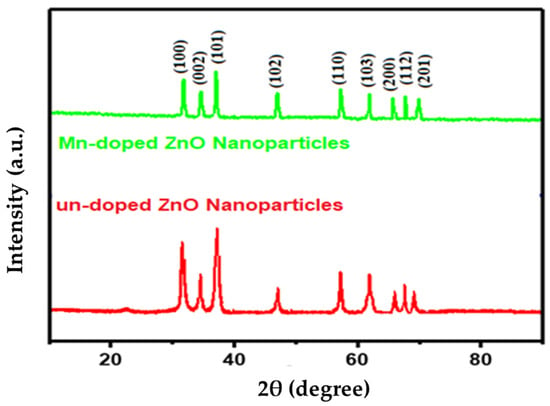
Figure 1.
XRD pattern of ZnO and Mn-doped ZnO nanoparticles.
2.2. TEM and EDX Analysis
The morphological structure of Mn-ZnO NPs is described using TEM images in Figure 2A. The particles exhibit circular and semicircular morphologies. TEM analysis for the prepared Mn-doped ZnO revealed that the sizes of the produced particles were in the range of 20–80 nm. However, the average size of the nanoparticles was found to be 74 nm, as exhibited by a size distribution graph (Figure 2B). The purity and composition of the fabricated Mn-ZnO NPs was confirmed through the EDX analysis. The EDX spectrum of Mn-ZnO contained Zn, O, and Mn peaks, confirming the successful synthesis of the NPs. No additional peak was present in the EDX spectrum, confirming the purity of the Mn-ZnO NPs (Figure 2C).
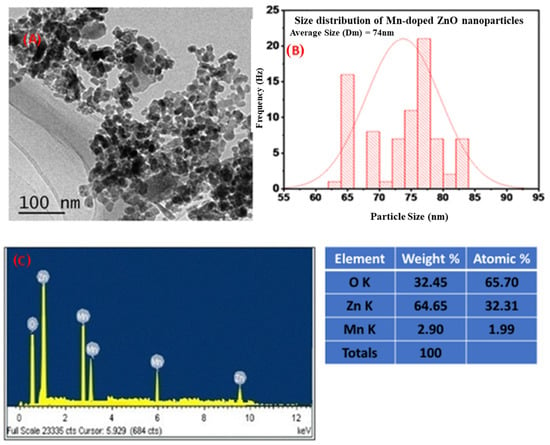
Figure 2.
TEM image of Mn-ZnO nanoparticles. (A) Size distribution of Mn-ZnO nanoparticles, showing the average particle sizes of nanoparticles. (B) EDX pattern of Mn-ZnO, showing the purity of the sample (C).
2.3. Physicochemical Analysis of Biodiesel
The transesterification process, catalyzed by Mn-doped ZnO, led to biodiesel production, which was further analyzed to gauge its quality. ASTM standards provide the information listed below in Table 1, indicating that the produced biodiesel showed a close resemblance with traditional biodiesel.

Table 1.
Physicochemical properties of biodiesel produced from castor oil.
2.4. Factors Effecting Yield of Biodiesel
2.4.1. Amount of Catalyst
The transesterification reaction is significantly influenced by the catalyst concentration. Therefore, the quantity of catalyst used must be checked during biodiesel generation. In the current study, the amount of catalyst used to perform the transesterification reaction varied from 0.4 g to 1.4 g in six experiments, keeping the amount of oil, the temperature, and all other conditions constant. The biodiesel yields obtained with varying amounts of the nanocatalyst are shown in Figure 3. Figure 3 shows that the maximum yield of biodiesel (90.3%) was obtained in experiment No. 5, using 1.2 g of the (Mn-doped ZnO) catalyst, and a further increase in the amount of catalyst resulted in a decrease in the yield of biodiesel because adding too much of the catalyst increased the viscosity of the solution and the yield of biodiesel decreased [33]. The results are summarized in Table 2.
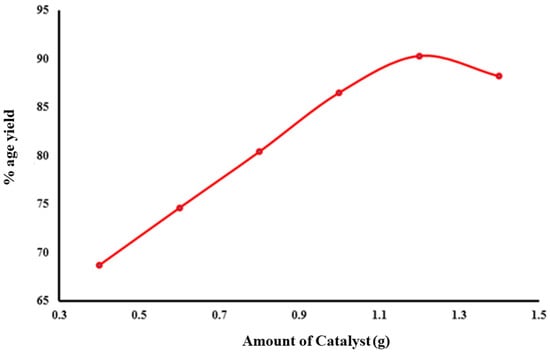
Figure 3.
Graph showing the effect of the catalyst dose in grams on the percentage yield of biodiesel.

Table 2.
Various factors, such as the amount of catalyst, methanol ration, and temperature, affecting the yield of biodiesel.
2.4.2. Amount of Methanol
The effect of the methanol concentration upon the yield of biodiesel was further investigated, comparing various amounts of methanol, while keeping other parameters constant, including the amounts of oil (one mL) and catalyst (1.2 g), as well as the temperature (55 °C). Experiments were conducted to study the dependency of the biodiesel yield on the amount of methanol used in each transesterification reaction. Table 2 indicates different values of biodiesel produced using various amounts of methanol. We observed that when increasing the methanol amount, the biodiesel yield increased to 88% at a 12:1 ratio of methanol to oil. Afterwards, the yield of biodiesel decreased with the increase in the methanol ratio. Figure 4 shows the optimum methanol-to-oil ratio (12:1) with the maximum yield (88%).
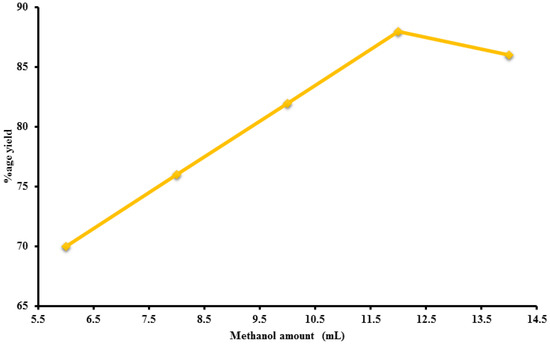
Figure 4.
Graph showing the effect of methanol concentration changes on the percentahe yield of biodiesel.
2.4.3. Reaction Temperature
The biodiesel production was also measured at temperatures ranging from 50 °C to 65 ° C, keeping all other parameters constant, as shown in Table 2. We observed that the yield of biodiesel increased with an increase in temperature up to 55 °C, and a further rise in temperature resulted in a decrease in the yield of biodiesel, as shown in Figure 5. In fact, the yield increased along with the increase in temperature because of an increase in the solubility of the solvent but a further increase in temperature resulted in the evaporation of methanol, which decreased the biodiesel yield, as shown in Figure 5 [11].
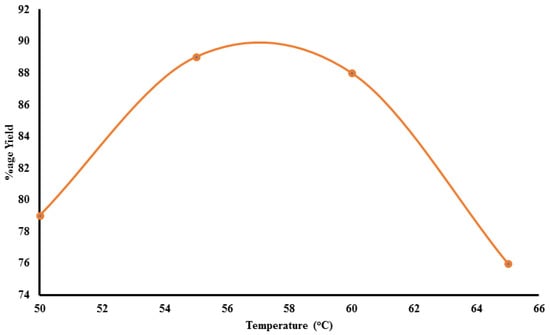
Figure 5.
Graph showing the effect of temperature change on the percentage yield of biodiesel.
2.5. Kinetics of Transesterification Reaction
Multiple chemical reactions under various conditions were carried out for the production of biodiesel in order to calculate kinetics and thermodynamic parameters.
2.5.1. Pseudo-First-Order Reaction
A pseudo-first-order kinetic model was applied to find out the rate of the transesterification reaction on the basis of the amount of reactant taken for the chemical reaction. For this purpose, a lower quantity of castor oil was taken as compared to the quantity of methanol (1:12). Methanol did not change its concentration during the chemical reaction and remained constant; therefore, methanol was excluded from the rate equation. Mechanistic analysis revealed that the transesterification reaction consisted of three steps:
Step 1:
Step 2:
Step 3:
Generally, the transesterification of castor oil can be expressed as:
where C, M, E, and G were castor oil, methanol ester, and glycerol
Based on the information presented above, the equation rate law is written as follows:
where K is the proportionality constant.
Because methanol was used in excess for a specific reaction, its concentration did not alter during the chemical reaction, unlike castor oil, which was used in a smaller amount.
Therefore,
The integrated form of Equation (2) is as follows:
Here, the initial concentration of castor oil before to start the reaction = CO and the concentration of castor oil at time (t) during the chemical reaction = C.
Hence, the above equation can be written as
Rearranging Equation (5),
Taking on both sides,
Comparing Equations (2) and (6),
The amount of FFA was determined via a chemical method by titrating it with 0.01 M KOH.
2.5.2. Rate Constant of the Transesterification Reaction
Samples were withdrawn at regular intervals and the amount of FFA was determined via a titration method using standard alkali (0.01 M KOH). The change in the concentration of FFA at regular intervals indicated the formation of biodiesel via an esterification reaction. The rate constant and other related parameters are given in Table 3.

Table 3.
Change in the concentration of FFA with time; intervals expressed in minutes.
Figure 6A is a plot of the data, comparing decreasing FFA concentrations and the reaction time. The linear portion of the straight line describes the process of the transesterification reaction, whereas the horizontal portion reveals that the reaction reached an equilibrium, where the amounts of the reactants and products became constant. The rate constant for the esterification reaction was determined based on the linear portion of the curve, as shown in Figure 6B.
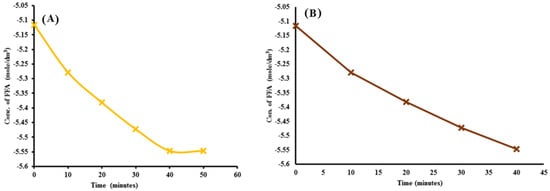
Figure 6.
Graph showing progress of the esterification reaction at a constant temperature (55 °C). (A) Linear portion of the graph, showing the progress of the reaction, used to calculate the rate of the esterification reaction at a constant temperature (55 °C) (B).
2.6. Activation Energy
The transesterification reaction was carried out at three different temperatures (50 °C, 55 °C, and 60 °C) and the progress of the reaction was monitored by means of the titration method. A graph comparing ln (Ct/Co) and time was plotted, as shown in Figure 7a. The graph showed the completion of the reaction. The linear part of the plot of ln (Ct/Co) against time was used to calculate the rate constant for the transesterification reaction, as shown in Figure 7b. From these rate constants, different thermodynamic parameters were calculated using the Arrhenius (Equation (8)) and Eyring equations (Equation (9)). The Arrhenius equation was used to find the activation energy of the transesterification reaction used to produce biodiesel [34,35].
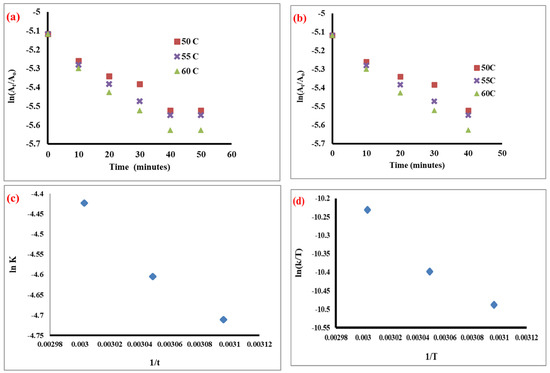
Figure 7.
Graph expressing the relationship between ln(At/Ao) and the time of the transesterification reaction at 50 °C, 55 °C, and 60 °C, showing the progress of the reaction. (a) Linear portion of the graph expressing the relationship between ln(At/Ao) and the time of the transesterification reaction at 50 °C, 55 °C, and 60 °C, used to calculate kapp for the transesterification reaction. (b) Arrhenius plot comparing ln(k) and 1/T for the calculation of the energy of activation of the transesterification reaction. (c) Eyring plot comparing ln(k/T) and 1/T for the calculation of the enthalpy and entropy of the transesterification reaction (d).
A graph was plotted comparing ln(k) and 1/T, which presented a straight line, as shown in Figure 7c. Based on the slope of the line expressing the calculated energy of activation, we observed a value of 25.68 kJ/mol for this transesterification reaction.
Similarly, the Eyring equation was used to calculate the free enthalpy and entropy of the activation of the transesterification reaction:
A plot expressing the relationship between ln(k/T) and 1/T was used to determine the free enthalpy and entropy of the activation of the reaction, as shown in Figure 7d. Based on this graph, we identified values of ΔH = 22.95 kJ/mol and ΔS = −0.1832 kJ/k. These values confirmed that the transesterification reaction was endergonic and entropy-driven.
3. Materials and Methods
3.1. Required Chemicals
Zinc acetate dihydrate Zn (CH3COO)2·2H2O) (98%), manganese chloride tetrahydrate MnCl2·4H2O (99%), polyethylene glycol, sodium hydroxide, NaOH (98%), castor oil, methanol CH3OH (99%), potassium hydroxide KOH (90%), phenolphthalein, and de-ionized water were used. All chemicals were purchased from Sigma Aldrich, (Billerica, MA, USA) and were used as such without further purification.
3.2. Preparation of Catalyst
Mn-doped ZnO nanoparticles were prepared using a method reported previously [36]. The synthesis of Zn1−xMnxO (x = 0.03) nanocrystals was carried out at room temperature by means of the ice-bath-assisted sonochemical method. 0.5 (1 − x) M Zn(CH3COO)2·2H2O, 0.5x M MnCl2·4H2O, and 2.5 g of PEG were dissolved in 100 mL double-distilled water under the same conditions with magnetic stirring to form the aqueous solution. Then, 1.0 M NaOH solution was added slowly into the above mixture to obtain a pH of 12.95 at 25 °C. The obtained mixture was then placed in an ultra-sonicator (CP-104, 20 kHz, Tierratech, Billerica, MA, USA) for one hour to allow a chemical reaction and the reaction temperature was stabilized at room temperature using an ice-bath. Yellowish precipitates were observed and accumulated at the bottom of the reaction mixture, which was centrifuged, filtered, and washed with de-ionized water and ethanol. Precipitates were dried in oven at 80 °C for 18 h.
3.3. Characterization
TEM images of Mn-doped ZnO nanoparticles were recorded using an FESEM JSM-7500F system (JEOL, Billerica, MA, USA) operating at 60 kV. For TEM analysis, suspensions were spread on carbon-coated copper grids and air-dried. For XRD of both pure and hybrid microgel, an X’pert PRO PANalytical Xpert system with CuKα (λ = 1.5406 A°) was used, whereas SEM-EDS was used to detect the morphology (Hitachi, S-4800, Tokyo, Japan) and the elements present.
3.4. Transesterification Process
The batch process was adopted for biodiesel production because of methanol’s sensitivity and rapid evaporation. The reaction was carried out in a three-neck round-bottom flask, which was placed on a magnetic and heating stirrer. A water condenser was fitted at one of the necks of the round-bottom flask. A thermometer was placed on the round-bottom flask’s second neck to monitor the reaction chamber’s temperature. The third neck was closed with replaceable aluminum foil, and the sample was extracted for analysis through this neck from time to time until the completion of the chemical reaction. Castor oil was first heated up to 65 °C (component-A), and parallel with this, methanol and catalyst were mixed in another flask. One-hundred milliliters of castor oil was taken against 200 mL methanol and 1 g of catalyst. The reaction was then allowed to proceed for one hour (60 min) to obtain three phased products, of which two were immiscible liquids, whereas one was a solid catalyst. The upper layer consisted of biodiesel, and the lower layer of the liquid was diagnosed as glycerol, having a comparatively higher density than the required biodiesel. The mixture was then filtered to retrieve the solid catalyst from the liquid layers [22].
3.5. Physicochemical Studies of Biodiesel
The kinematic viscosity of the biodiesel was calculated in centistrokes (cSt).
where t = t2 − t1 = the time taken by sample to flow between two graduated points of the viscometer and k is the constant of the viscometer.
Vkm = t × k
The flash point of biodiesel is higher than that of the standard petroleum diesel used in motor vehicles. The flash point of biodiesel in this study was measured on the pattern of ISO-3679. Similarly, the cloud point, pour point, cetane number, and density were calculated based on ASTM standards.
3.6. Kinetic Study of Transesterification Process
To study kinetic parameters such as the order, rate, and molecularity of the reaction, first-order chemical kinetics was followed, which was most suitable depending upon the given reaction conditions. The contents of FFA were titrated against 0.01 M KOH by taking out the sample continuously after an equal interval of 10 min during transesterification from the reaction mixture. The first-order reaction model was further extended to measure the activation energy, enthalpy, and the entropy of transesterification.
4. Conclusions
In the current study, the transesterification of castor oil to produce biodiesel using Mn-ZnO nanoparticles as a catalyst was investigated. Mn-ZnO nanoparticles with average particle sizes of 74 nm were synthesized using the ice-bath-assisted sonochemical method. The characteristics of the biodiesel produced with the nanocatalyst, such as the kinematic viscosity (4.7 mm2 s−1), density (900 kg m−3), cloud point (1 °C), flash point (122 °C), and pour point (2 °C) indicated the success of the transesterification reaction adopted to produce the biodiesel. The kinetics of the reaction were studied in detail, considering all the basic parameters. A pseudo-first-order kinetics model was used to obtain information on the rate of the reaction, which further allowed us to measure the activation energy (Ea = 25.68 kJ mol−1), enthalpy (ΔH = 22.95 kJ mol−1), and entropy (ΔS = −0.1832 kJ/k). The obtained data indicated that the transesterification reaction was endothermic and non-spontaneous, requiring a continuous supply of energy to form the methyl ester. The optimum temperature, catalyst amount, and oil-to-methanol ratio were identified as 55 °C, 1.2 g, and 1:12, respectively, leading to the maximum biodiesel yield (90.3%). Finally, the Mn-ZnO catalyst displayed excellent potential for commercialization due to its optimal efficiency in the manufacturing of biodiesel, its environmental friendliness, and its easy and affordable synthesis technique.
Author Contributions
Formal analysis, A.Z. and Z.M.; writing—original draft, M.A.Q.; methodology, M.S. (Mohammad Shariq) and M.A.H.; resources, M.A.H. and S.I.; software, H.J.A.; supervision, S.S. and M.A.H.; validation, S.K.A. and M.S.K.; visualization, B.R.P. and M.S.A.A.; writing—review & editing, Z.N. and M.S (Mudassar Sher). All authors have read and agreed to the published version of the manuscript.
Funding
This work has been funded by the Deanship of Scientific Research at King Khalid University, Abha, Kingdom of Saudi Arabia through Large Groups RGP.2/43/43.
Data Availability Statement
Not applicable.
Acknowledgments
The authors extend their appreciation to the Deanship of Scientific Research at King Khalid University, Abha, Kingdom of Saudi Arabia for funding this work through Large Groups RGP.2/43/43.
Conflicts of Interest
The authors declare no conflict of interest.
References
- Mahmudul, H.; Hagos, F.Y.; Mamat, R.; Adam, A.A.; Ishak, W.F.W.; Alenezi, R. Production, characterization and performance of biodiesel as an alternative fuel in diesel engines—A review. Renew. Sustain. Energy Rev. 2017, 72, 497–509. [Google Scholar] [CrossRef]
- Balat, M.; Balat, H. Biogas as a renewable energy source—A review. Energy Sources Part A 2009, 31, 1280–1293. [Google Scholar] [CrossRef]
- Chaudhary, P.; Kumar, B.; Kumar, S.; Gupta, V.K. Transesterification of Castor Oil with Methanol–Kinetic Modelling. Chem. Prod. Process Model. 2015, 10, 71–80. [Google Scholar] [CrossRef]
- Karmakar, B.; Dhawane, S.H.; Halder, G. Optimization of biodiesel production from castor oil by Taguchi design. J. Environ. Chem. Eng. 2018, 6, 2684–2695. [Google Scholar] [CrossRef]
- Yan, S.; Mohan, S.; DiMaggio, C.; Kim, M.; Ng, K.S.; Salley, S.O. Long term activity of modified ZnO nanoparticles for transesterification. Fuel 2010, 89, 2844–2852. [Google Scholar] [CrossRef]
- Soliman, M.M.; Karmakar, A.; Alegria, E.C.; Ribeir, A.P.; Rúbio, G.M.; Saraiva, M.S.; da Silva, M.F.C.G.; Pombeiro, A.J. ZnO nanoparticles: An efficient catalyst for transesterification reaction of α-keto carboxylic esters. Catal. Today 2020, 348, 72–79. [Google Scholar] [CrossRef]
- Wang, A.; Quan, W.; Zhang, H.; Li, H.; Yang, S. Heterogeneous ZnO-containing catalysts for efficient biodiesel production. RSC Adv. 2021, 11, 20465–20478. [Google Scholar] [CrossRef]
- Jayakumar, M.; Karmegam, N.; Gundupalli, M.P.; Gebeyehu, K.B.; Asfaw, B.T.; Chang, S.W.; Balasubramani, R.; Awasthi, M.K. Heterogeneous base catalysts: Synthesis and application for biodiesel production—A review. Bioresour. Technol. 2021, 331, 125054. [Google Scholar] [CrossRef]
- Deshmane, V.G.; Adewuyi, Y.G. Synthesis and kinetics of biodiesel formation via calcium methoxide base catalyzed transesterification reaction in the absence and presence of ultrasound. Fuel 2013, 107, 474–482. [Google Scholar] [CrossRef]
- Ma, Y.; Wang, Q.; Sun, X.; Wu, C.; Gao, Z. Kinetics studies of biodiesel production from waste cooking oil using FeCl3-modified resin as heterogeneous catalyst. Renew. Energy 2017, 107, 522–530. [Google Scholar] [CrossRef]
- Baskar, G.; Soumiya, S. Production of biodiesel from castor oil using iron (II) doped zinc oxide nanocatalyst. Renew. Energy 2016, 98, 101–107. [Google Scholar] [CrossRef]
- Mapossa, A.B.; Dantas, J.; Costa, A.C. Transesterification reaction for biodiesel production from soybean oil using Ni0. 5Zn0. 5Fe2O4 nanomagnetic catalyst: Kinetic study. Int. J. Energy Res. 2020, 44, 6674–6684. [Google Scholar] [CrossRef]
- Kumar, S.; Deswal, V. Optimization at low temperature transesterification biodiesel production from soybean oil methanolysis via response surface methodology. Energy Sources Part A Recovery Util. Environ. Eff. 2022, 44, 2284–2293. [Google Scholar] [CrossRef]
- Halek, F.; Delavari, A.; Kavousi-Rahim, A. Production of biodiesel as a renewable energy source from castor oil. Clean Technol. Environ. Policy 2013, 15, 1063–1068. [Google Scholar] [CrossRef]
- Baskar, G.; Gurugulladevi, A.; Nishanthini, T.; Aiswarya, R.; Tamilarasan, K. Optimization and kinetics of biodiesel production from Mahua oil using manganese doped zinc oxide nanocatalyst. Renew. Energy 2017, 103, 641–646. [Google Scholar] [CrossRef]
- Ambat, I.; Srivastava, V.; Sillanpää, M. Recent advancement in biodiesel production methodologies using various feedstock: A review. Renew. Sustain. Energy Rev. 2018, 90, 356–369. [Google Scholar] [CrossRef]
- Donkova, B.; Dimitrov, D.T.; Kostadinov, M.; Mitkova, E.; Mehandjiev, D. Catalytic and photocatalytic activity of lightly doped catalysts M: ZnO (M = Cu, Mn). Mater. Chem. Phys. 2010, 123, 563–568. [Google Scholar] [CrossRef]
- Muruganandham, M.; Wu, J. Synthesis, characterization and catalytic activity of easily recyclable zinc oxide nanobundles. Appl. Catal. B Environ. 2008, 80, 32–41. [Google Scholar] [CrossRef]
- Wojnarowicz, J.; Chudoba, T.; Lojkowski, W. A review of microwave synthesis of zinc oxide nanomaterials: Reactants, process parameters and morphologies. Nanomaterials 2020, 10, 1086. [Google Scholar]
- Belkhaoui, C.; Lefi, R.; Mzabi, N.; Smaoui, H. Synthesis, optical and electrical properties of Mn doped ZnO nanoparticles. J. Mater. Sci. Mater. Electron. 2018, 29, 7020–7031. [Google Scholar] [CrossRef]
- Khalid, R.; Alhazaa, A.N.; Khan, M. Synthesis, characterization and properties of Mn-doped ZnO nanoparticles. Appl. Phys. A 2018, 124, 1–8. [Google Scholar] [CrossRef]
- Baskar, G.; Selvakumari, I.A.E.; Aiswarya, R. Biodiesel production from castor oil using heterogeneous Ni doped ZnO nanocatalyst. Bioresour. Technol. 2018, 250, 793–798. [Google Scholar] [CrossRef] [PubMed]
- Birajdar, S.D.; Alange, R.; More, S.; Murumkar, V.; Jadhav, K. Sol-gel auto combustion synthesis, structural and magnetic properties of Mn doped ZnO nanoparticles. Procedia Manuf. 2018, 20, 174–180. [Google Scholar] [CrossRef]
- Bonifácio, M.A.R.; Lira, H.D.L.; Neiva, L.S.; Kiminami, R.H.G.A.; Gama, L. Nanoparticles of ZnO doped with Mn: Structural and morphological characteristics. Mater. Res. 2017, 20, 1044–1049. [Google Scholar] [CrossRef]
- Ahmad, I. Comparative study of metal (Al, Mg, Ni, Cu and Ag) doped ZnO/g-C3N4 composites: Efficient photocatalysts for the degradation of organic pollutants. Separ. Purif. Technol. 2020, 251, 117372. [Google Scholar] [CrossRef]
- Shatnawi, M.; Alsmadi, A.; Bsoul, I.; Salameh, B.; Mathai, M.; Alnawashi, G.; Alzoubi, G.M.; Al-Dweri, F.; Bawa’Aneh, M. Influence of Mn doping on the magnetic and optical properties of ZnO nanocrystalline particles. Results Phys. 2016, 6, 1064–1071. [Google Scholar] [CrossRef]
- Kumar, P.; Singh, B.K.; Pal, B.N.; Pandey, P.C. Correlation between structural, optical and magnetic properties of Mn-doped ZnO. Appl. Phys. A 2016, 122, 740. [Google Scholar] [CrossRef]
- Shanmugam, N.; Suthakaran, S.; Kannadasan, N.; Kumar, K.S. Synthesis and characterization of Te doped ZnO nanosheets for photocatalytic application. J. Heterocycl. 2015, 105, 15–20. [Google Scholar] [CrossRef]
- Ahmad, A.; Wei, Y.; Syed, F.; Tahir, K.; Rehman, A.U.; Khan, A.; Ullah, S.; Yuan, Q. The effects of bacteria-nanoparticles interface on the antibacterial activity of green synthesized silver nanoparticles. Microb. Pathogen. 2017, 102, 133–142. [Google Scholar] [CrossRef]
- Kotresh, M.; Patil, M.; Inamdar, S. Reaction temperature based synthesis of ZnO nanoparticles using co-precipitation method: Detailed structural and optical characterization. Optik 2021, 243, 167506. [Google Scholar] [CrossRef]
- Sher, M.; Khan, S.A.; Shahid, S.; Javed, M.; Qamar, M.A.; Chinnathambi, A.; Almoallim, H.S. Synthesis of novel ternary hybrid g-C3N4@ Ag-ZnO nanocomposite with Z-scheme enhanced solar light-driven methylene blue degradation and antibacterial activities. J. Environ. Chem. Eng. 2021, 9, 105366. [Google Scholar] [CrossRef]
- Qamar, M.A.; Shahid, S.; Javed, M.; Sher, M.; Iqbal, S.; Bahadur, A.; Li, D. Fabricated novel g-C3N4/Mn doped ZnO nanocomposite as highly active photocatalyst for the disinfection of pathogens and degradation of the organic pollutants from wastewater under sunlight radiations. Colloid. Surf. A Physicochem. Eng. Asp. 2021, 611, 125863. [Google Scholar] [CrossRef]
- Zhang, L.; Sheng, B.; Xin, Z.; Liu, Q.; Sun, S. Kinetics of transesterification of palm oil and dimethyl carbonate for biodiesel production at the catalysis of heterogeneous base catalyst. Bioresour. Technol. 2010, 101, 8144–8150. [Google Scholar] [CrossRef] [PubMed]
- Li, L.; Yan, B.; Li, H.; Yu, S.; Liu, S.; Yu, H.; Ge, X. SO42−/ZrO2 as catalyst for upgrading of pyrolysis oil by esterification. Fuel 2018, 226, 190–194. [Google Scholar] [CrossRef]
- Galvan, D.; Orives, J.R.; Coppo, R.L.; Silva, E.T.; Angilelli, K.G.; Borsato, D. Determination of the kinetics and thermodynamics parameters of biodiesel oxidation reaction obtained from an optimized mixture of vegetable oil and animal fat. Energy Fuels 2013, 27, 6866–6871. [Google Scholar] [CrossRef]
- Othman, A.; Osman, M.; Ibrahim, E.; Ali, M.A.; Abd-Elrahim, A. Mn-doped ZnO nanocrystals synthesized by sonochemical method: Structural, photoluminescence, and magnetic properties. Mater. Sci. Eng. B 2017, 219, 1–9. [Google Scholar] [CrossRef]
Disclaimer/Publisher’s Note: The statements, opinions and data contained in all publications are solely those of the individual author(s) and contributor(s) and not of MDPI and/or the editor(s). MDPI and/or the editor(s) disclaim responsibility for any injury to people or property resulting from any ideas, methods, instructions or products referred to in the content. |
© 2023 by the authors. Licensee MDPI, Basel, Switzerland. This article is an open access article distributed under the terms and conditions of the Creative Commons Attribution (CC BY) license (https://creativecommons.org/licenses/by/4.0/).